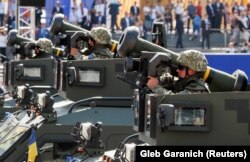On April 3, as North Atlantic Treaty Organization (NATO) foreign ministers gathered in Washington, DC to mark the alliance’s 70th anniversary, the Russian state media shared a report claiming NATO support for the Ukrainian navy was “laughable” and the ships provided to Ukraine by NATO states are nothing but “junk.”
These claims, attributed to Andrei Koshkin, head of the political science and sociology department at the prestigious Plekhanov Academy, were broadcast on Sputnik radio and then republished by several other government media outlets, including RIA Novosti.
According to RIA Novosti, Koshkin was asked to comment on that day’s announcement by Alexander Vinnikov, head of NATO representative office in Ukraine, who said the Ukrainian navy will be training with the NATO ships deployed to the Black Sea ports controlled by Kyiv.
Koshkin said it was “laughable” to try and train the Ukrainian navy on the NATO ships while they are located in Ukrainian ports, and that no training can substitute for a real service on military ships – experience that Ukraine does not have.
He also claimed the military vessels NATO states are offering to Kyiv are “in essence, junk.”
Koshkin’s claims are false.
‘Extremely difficult situation’
The claim that the situation with Ukraine’s navy is “extremely difficult,” is no longer true, the co-founder of the Military in UA web portal, Olexandr Argat, told Polygraph.info.
“Ukraine has built nine vessels for the navy during the last five years: seven of them are Gurza-M class boats and the other two are Centaur-class. These are small ships but they are our own and new,” Argat said.
Gurza-M class boats are small armored artillery boats used to patrol harbors, rivers, lakes, territorial waters and isolated areas. Other missions include protection of Ukraine’s borders and river ports, assistance to aircraft or vessels in distress, and combating illegal migration, piracy and smuggling on the Danube River and in the waters of the Black Sea-Azov basin.
Centaur-class fast assault craft are used to provide fire support and ensure the rapid deployment of marines and Special Forces. They can also perform a wide range of missions, including maritime patrol, surveillance, search-and-rescue (SAR), safeguarding littoral and inland waters, and troop transport.
‘Laughable NATO training’
NATO Secretary-General Jens Stoltenberg said last December that “NATO is helping with different trust funds on cyber, on command and control and we also help to modernize the Ukrainian navy," including by providing intense training to the Ukrainian navy.
NATO support for Ukraine is regulated under the Wales Summit Declaration of September 2014, which was followed by four declarations ensuring and enhancing NATO support for Ukraine.
NATO members, including the United States, United Kingdom and others, have regularly held enhanced training exercises with Ukrainian troops, including from the Ukrainian navy.
According to the Military Times, from July to September 2018], the U.S. Marine Corps “kicked off three training evolutions with partner forces in Ukraine, Romania, and Georgia.”
Interactive Liveuamap portal shows the activities of the NATO and Ukrainian navy, including the joint NATO-Ukraine drill: Matka-class missile boat "Pryluky" (U153) and Halifax-class frigate HMCS Toronto (FFH 333) held in July 2018.
In September 2018, Ukraine’s navy reportedly conducted joint training with the USS James E. Williams destroyer.
‘NATO deliveries… in essence, junk’
“NATO does not provide ships to Ukraine,” the alliance’s press office told Polygraph.info, noting that NATO member states are independently providing vessels to the Ukrainian navy.
In 2017, Ukrainian Vice Admiral Ihor Voronchenko said that Ukraine’s navy is looking into the purchase of decommissioned NATO ships for its fleet in order to fulfill Ukraine’s role in occupying a significant portion of the Black Sea coastline.
Denmark, Lithuania, Poland, Tanzania and the United States have sold or rebuilt -- or are in the process of negotiating the delivery of military vessels -- to Kyiv.
Listed among Ukrainian Navy active vessels are:
- One Danish Flyvefisken Class multirole vessel. Built in Denmark between 1987 and 1996, decommissioned in 1989. The Flyvefisken Class multirole vessel is based on a modular concept, using a standard hull with containerized weapon systems and equipment, which allows the vessel to change roles quickly for surveillance, surface combat, anti-submarine warfare, mine countermeasures/minehunter, minelayer or pollution control.
- The Pereyaslav, a Muna Class small reconnaissance ship built in Lithuania. Originally named GS-13 in the Soviet Navy. Launched in 1986 and transferred to Ukraine in 1995.
- Seven Polish ships, including the U-602 Alchevsk, a Moma Class intelligence ship; the U401 Yuri Olefirenko, a Polnochny-C Class a mid-size landing ship; three PO-2 Class training ships; the U-811 Balta, a Bereza Class degaussing ship; and the U-500 Donbas, an Amur Class command/SAR ship.
- Two U.S. Island Class patrol cutters. As described by the Military Navigator portal, “[t]he 110-foot Island-class Patrol Boats are a Coast Guard modification of a highly successful British-designed patrol boat. With excellent range and seakeeping capabilities, the Island Class, all named after U.S. islands, replaced the older 95-foot Cape-class patrol boats. These cutters are equipped with advanced electronics and navigation equipment.”
- Two U.S. Oliver Hazard Perry Class guided missile frigates have been offered to Ukraine, and Ukrainian Navy sailors have been training on them in the United States.
'Propaganda' and 'False'
John Herbst, director of the Atlantic Council’s Eurasia Center and former U.S. Ambassador to Uzbekistan (2000-2003) and to Ukraine (2003-2006), told Polygraph.info, Koshkin’s statement is “propaganda.”
”The ships that we have been able to provide to Ukraine are coast guard cutters; they are real ships, not junk, they will be of serious use to Ukraine’s navy. So, these statements are simply false,” Herbst said.
Herbst said that Moscow’s claim of ownership over parts of the Black Sea, including the Kerch Strait, are “in complete violation of international law.” Russia is only one of the Black Sea powers, which also include several NATO nations, Bulgaria, Romania and Turkey, all of which have navies.
“It is true that NATO has taken a more forward presence in the Black Sea in response to Russian aggression against Ukraine, but I am not expecting NATO nations to challenge the Kremlin in the Kerch Strait, but I do expect a greater NATO presence in the east of the Black Sea.”
Koshkin, like many in Russia, called NATO’s aid to Ukraine a “provocation” and threatened a strong response by Moscow.
“Mr. Putin is a bully; he becomes more aggressive when he sees weakness,” said Herbst.
He added that the Kremlin voiced the same threats when the U.S. announced it would provide Ukraine with the Javelin anti-tank missile system.
“Trump decided to do that, the Javelins arrived over a year ago and there is still no Russian reaction,” Herbst said.








